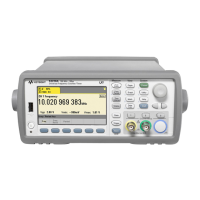3 53220A/53230A Measurements
88 Keysight 53220A/53230A User’s Guide
Same subsystem For commands that share the same subsystem, multiple
commands can also be sent in a single string. The first command references the
root node, and subsequent commands separated by semicolons, are referenced to
the same level as the previous command. As an example, the command sequence
representing the CALCulate2 subsystem:
CALC2:TRAN:HIST:STAT ON
CALC2:TRAN:HIST:POIN 15
CALC2:TRAN:HIST:RANG:AUTO ON
CALC2:TRAN:HIST:RANGe:AUTO:COUNt 300
can be sent in a string as:
CALC2:TRAN:HIST:STAT ON;POIN 15;RANG:AUTO ON;AUTO:COUN 300
Separate command lines or strings? Sending commands in a single string
rather than in separate command lines can eliminate “settings conflict” errors.
When sent on separate lines, the counter checks for errors as each command
(line) is parsed. When sent as a string, the entire string is parsed before error
conditions are checked.
Linking IEEE 488-2 common commands and SCPI commands
In a command string containing both IEEE 488.2 common commands (e.g. *RST,
*WAI, *OPC?) and SCPI instrument commands, the common commands are
separated from the SCPI commands by a semicolon (;). An example is shown in
the following string:
CALC:STAT ON;AVER:STAT ON;:INIT;*WAI;:CALC:AVER:AVER?

